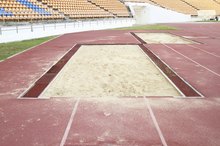Heptathlon Vs. Decathlon
The heptathlon and decathlon are combined track and field events that require a wide range of skills 1. The two competitions, both of which are contested in the Olympics, comprise several track and field disciplines, and some of the greatest names in track and field history include champions of the heptathlon and decathlon. Though the heptathlon and decathlon share some events, there are key differences, both in who performs in the competitions and the number of events that comprise them.
If you are experiencing serious medical symptoms, seek emergency treatment immediately.
Heptathlon
The heptathlon consists of seven events and is a standard part of men and women's indoor track and field competitions, but only women compete in the heptathlon outdoors and in the heptathlon in the Olympics 1. Men's indoor track events often include the heptathlon.
Decathlon
History of the Long Jump
Learn More
The decathlon is a 10-discipline combined track and field event that is primarily a men's event 1. A decathlon is sometimes held in women's track and field events, but not at major international competitions such as the Olympics 1. The events in the men's decathlon include:
- the 100 m
- long jump
- shot put
- high jump
- 400 m
- 110 m hurdles
- discus throw
- pole vault
- javelin throw
- 1,500 m
The women's decathlon includes the same events.
Scheduling and Scoring
Both the heptathlon and decathlon are held over two days and a half-hour rest typically is provided between the end of one event at the start of another, with five events contested each day in the decathlon and four events the first day and three events the second day in the heptathlon. Scoring is based on an 8,500-point scale for the decathlon and 7,000 points for the heptathlon. The International Association of Athletics Foundations establishes scoring tables that assign a point value for a specific time in a race or a specific height or distance in a field event. For example, in the men's 1,500 m, a time of 4:10.37 minutes is worth 879 points. A faster time is worth more points and a slower time is worth fewer points. If an athlete posts a time or a distance that isn't specifically on the scoring table, the athlete is given the points for the next slowest or next shortest figure. The scoring tables are designed to make sure specialists in a couple of events aren't given an advantage over more well-rounded athletes.
- Both the heptathlon and decathlon are held over two days and a half-hour rest typically is provided between the end of one event at the start of another, with five events contested each day in the decathlon and four events the first day and three events the second day in the heptathlon.
History
Women's Golf in the 1920s
Learn More
The decathlon and heptathlon owe their existence to the five-event pentathlon in the ancient Greek Olympics. With the advent of the modern Olympic Games, track and field events were altered and the 10-event decathlon emerged as a marquee event 1. When American Jim Thorpe won the decathlon in the 1912 Olympics in Sweden, King Gustav V declared Thorpe "the world's greatest athlete," a title that has since stuck to the winner of the Olympic decathlon. Other decathlon gold medalists through the years include Americans Bob Mathias, who won it twice, Rafer Johnson and Bruce Jenner. The quest for a women's combined event, once women were admitted to the Olympics, led to the heptathlon. Among the all-time greats are American Jackie Joyner-Kersee and Carolina Kluft of Sweden.
- The decathlon and heptathlon owe their existence to the five-event pentathlon in the ancient Greek Olympics.
- When American Jim Thorpe won the decathlon in the 1912 Olympics in Sweden, King Gustav V declared Thorpe "the world's greatest athlete," a title that has since stuck to the winner of the Olympic decathlon.
Related Articles
References
Writer Bio
James Roland started writing professionally in 1987. A former reporter and editor with the "Sarasota Herald-Tribune," he currently oversees such publications as the "Cleveland Clinic Heart Advisor" and UCLA's "Healthy Years." Roland earned his Bachelor of Science in journalism from the University of Oregon.








